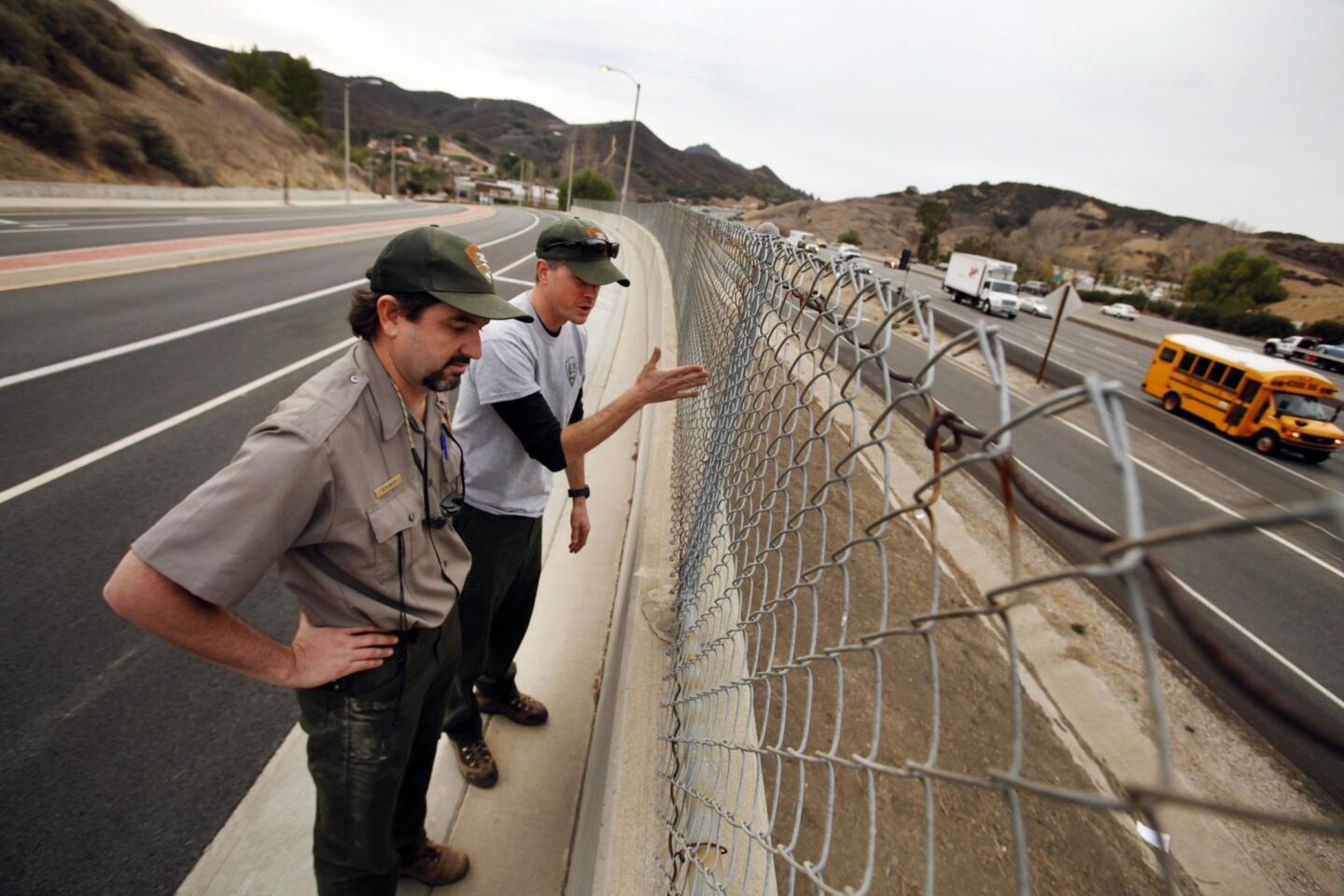Mountain lions in Santa Monica Mountains need more room, experts say
- Share via
From an urban puma’s perspective, the news of late from greater Los Angeles has been mixed.
On the positive front, a small population of mountain lions is surviving in the relatively compact confines of the Santa Monica Mountains, where deer are plentiful and cougars have found mates and reproduced. One healthy male mountain lion has made Griffith Park, in the range’s eastern reaches, his domain and dinette for nearly two years.
On the flip side, a cougar that would have brought new genetic material managed to cross the 101 Freeway last October but encountered a 10-foot retaining wall and was struck and killed by a motorist. In the latest sobering revelation, the National Park Service said this week that three mountain lion kittens born in the Santa Monica Mountains last month appear to be the result of inbreeding.
Taken together, scientists say, these developments underscore the need for easing the passage of wildlife between open lands now bisected by the 101 in Agoura Hills, about 30 miles northwest of downtown Los Angeles.
Mountain lions in the Santa Monicas are trapped on an island of habitat, constrained by freeways, the Pacific Ocean and the agricultural fields of Oxnard. The inbreeding is further evidence that male lions need more room to roam to expand their mating options, experts say.
“This is the third of six kitten litters we’ve studied where we’ve documented first-order inbreeding, in which a father mates with his offspring,” said Seth Riley, an urban wildlife expert at the Santa Monica Mountains National Recreation Area, a unit of the National Park Service. Riley and his team have studied mountain lions in the area for more than a decade.
Preliminary paternity results from UCLA’s Robert Wayne Lab indicate that Puma 12, known as P-12, is the father of the three new kittens and the father of their mother, P-19. The kittens — one male and two females known as P-32, P-33 and P-34 — were born in the Malibu Springs area; biologists attached ear tags to the youngsters last month.
Over multiple generations, inbreeding leads to a loss of genetic diversity and can result in low sperm counts, heart problems and lower resistance to disease.
P-12 was the first and so far only animal being tracked by Riley’s team whose crossing of the 101 has been documented. Scientists first collared the puma in late 2008 north of the freeway in the Simi Hills. He crossed the highway in February 2009 in the Liberty Canyon area. “He managed to cross and survive,” Riley said. (The lion is now 7 or 8 years old and has bred six times.)
The first radio collar failed soon after his crossing. A scientist recaptured him in the Santa Monicas in April 2009 and attached a new collar. By then, the lion “looked fairly beat up from tangles with other adult males,” Riley said.
Riley’s studies have shown that the top causes of death among the Santa Monica Mountains’ puma population are conflicts with other lions, exposure to rat poisons and encounters with moving vehicles.
The California Department of Transportation has twice sought federal funding for a $10-million tunnel crossing near the Liberty Canyon Road exit. The area is part of a critical wildlife corridor that connects the Santa Susana Mountains and Simi Hills to the Santa Monica Mountains.
Riley and others working with DOT recently proposed what they consider a superior option: a landscaped crossing over the freeway. Such overpasses have been successful in Canada and Europe and are starting to be used in the Western United States.
“I’m arguing pretty aggressively for an overpass,” said Joseph T. Edmiston, executive director of the Santa Monica Mountains Conservancy, which owns much of the land near the proposed crossing. “It would be more inviting for the animals.”
The Santa Monica Mountains Conservancy will consider next month whether to provide $200,000 so the California Department of Transportation can study alternatives. The cost of an over-crossing would far exceed the $10 million that has been projected for a tunnel.
A robust wildlife crossing “is the key to genetic health in the Santa Monica Mountains,” said Clark Stevens, executive officer of the Resource Conservation District of the Santa Monica Mountains. As high a priority as it is, Stevens said, “it will take a lot of separate money cobbled together” by a public-private partnership to build.
Barbara Marquez, senior environmental planner with the state Department of Transportation, said she has driven under wildlife over-crossings in Banff National Park in Canada. She described them as “pretty amazing” and said they were well used by bear, deer, elk and other animals.
She said the agency would study many options for easing the constraints on wildlife in the Santa Monicas. “We are working with our partner agencies,” she said, “to make sure we find a solution to this problem.”
More to Read
Sign up for Essential California
The most important California stories and recommendations in your inbox every morning.
You may occasionally receive promotional content from the Los Angeles Times.













